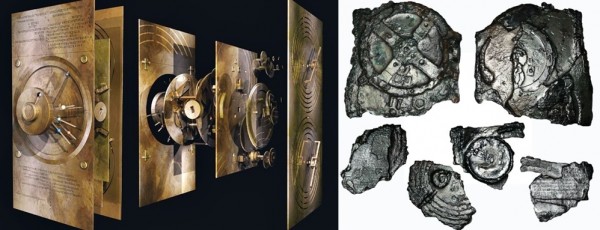Text of Fabulous Antikythera Mechanism Finally Deciphered after 2,000 Years
| Arthur Dominic Villasanta | | Jun 11, 2016 09:11 AM EDT |
The Antikythera Mechanism as it might have looked 2,000 years ago and as it was discovered.
It's regarded as the world's first mechanical computer and a mind boggling invention built 2,000 years ago in Greece and now, the fabled Antikythera Mechanism has surrendered one of its most intriguing secrets to modern science.
Scientists working over the past 10 years have finally deciphered the text in ancient Greek engraved on the back of this intricately built analog computer. They've long know is the Antikythera Mechanism is an astronomical calculator that predicted phenomena involving the Sun, Moon, stars and probably the five planets known to the ancient Greeks.
Like Us on Facebook
The mechanism showed the phases of the Moon; the position of the Sun and the Moon in the Greek zodiac and the position of the planets. It was also probably used to predict eclipses.
The use of the mechanism to predict eclipses has intrigued some scientists who think this feature was also used to predict the future.
"We are not quite sure how to interpret this, to be fair, but it could hark back to suggestions that the color of an eclipse was some sort of omen or signal. Certain colors might be better for what's coming than other colors," said Mike Edmunds, a professor of astrophysics from the University of Cardiff in Wales who was part of the research team.
The text was heavily encrusted in sediment and almost unreadable given the mechanism had lain on the bottom of the Mediterranean Sea before it was discovered in 1901. The mechanism was originally encased in a wooden box and was operated by a hand-crank. In all, 82 fragments were retrieved from the sea.
The letters, some just 1.2 millimeters tall, were engraved on the inside covers and visible front and back sections of the mechanism. There are some 3,500 letters of explanatory text, or about a quarter of the original, in the mechanism.
Armed with X-ray scanning equipment and imaging technology, an international team of scientists has read most of the explanatory text engraved in tiny letters on the surviving fragments of the Antikythera Mechanism.
The findings revealed the device was a kind of philosopher's guide to the galaxy. The text doesn't instruct a reader on the use of the device but is more like a descriptive label.
"It's like a textbook of astronomy as it was understood then, which connected the movements of the sky and the planets with the lives of the ancient Greeks and their environment," said Prof. Alexander Jones of New York University.
Jones said the text reveals a lot of detail "because it comes from a period from which we know very little about Greek astronomy and essentially nothing about the technology, except what we gather from here. So these very small texts are a very big thing for us."
"It was not a research tool, something that an astronomer would use to do computations, or even an astrologer to do prognostications, but something that you would use to teach about the cosmos and our place in the cosmos."
©2015 Chinatopix All rights reserved. Do not reproduce without permission
EDITOR'S PICKS
-

Did the Trump administration just announce plans for a trade war with ‘hostile’ China and Russia?
-

US Senate passes Taiwan travel bill slammed by China
-

As Yan Sihong’s family grieves, here are other Chinese students who went missing abroad. Some have never been found
-

Beijing blasts Western critics who ‘smear China’ with the term sharp power
-

China Envoy Seeks to Defuse Tensions With U.S. as a Trade War Brews
-

Singapore's Deputy PM Provides Bitcoin Vote of Confidence Amid China's Blanket Bans
-

China warns investors over risks in overseas virtual currency trading
-

Chinese government most trustworthy: survey
-

Kashima Antlers On Course For Back-To-Back Titles
MOST POPULAR
LATEST NEWS
Zhou Yongkang: China's Former Security Chief Sentenced to Life in Prison

China's former Chief of the Ministry of Public Security, Zhou Yongkang, has been given a life sentence after he was found guilty of abusing his office, bribery and deliberately ... Full Article
TRENDING STORY

China Pork Prices Expected to Stabilize As The Supplies Recover

Elephone P9000 Smartphone is now on Sale on Amazon India

There's a Big Chance Cliffhangers Won't Still Be Resolved When Grey's Anatomy Season 13 Returns

Supreme Court Ruled on Samsung vs Apple Dispute for Patent Infringement

Microsoft Surface Pro 5 Rumors and Release Date: What is the Latest?












